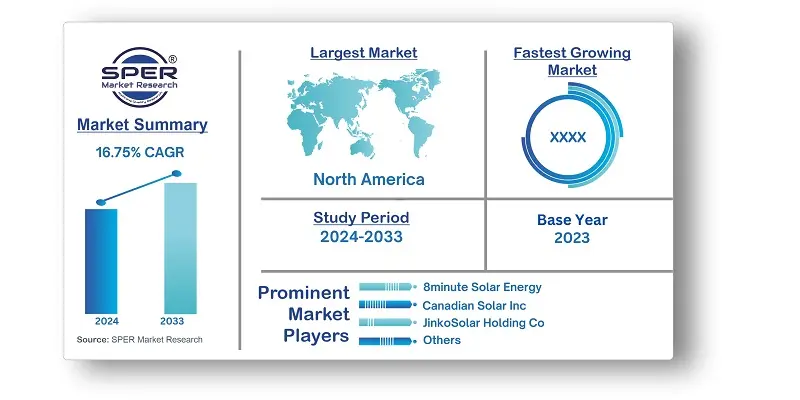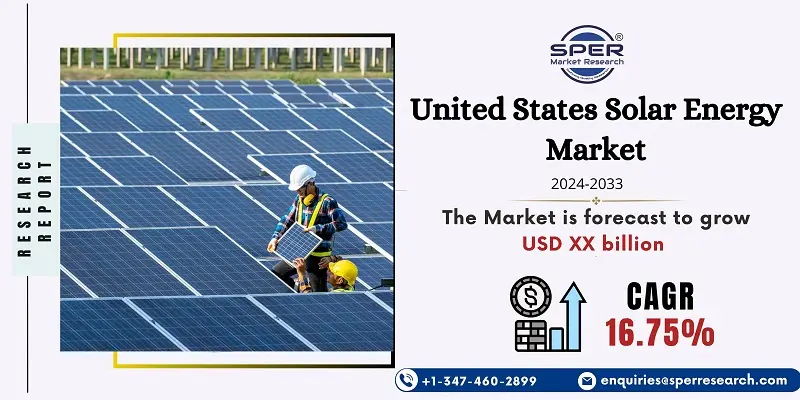
United States Solar Energy Market Growth, Size, Trends, Demand, Share and Future Outlook
United States Solar Energy Market Size- By Type- Regional Outlook, Competitive Strategies and Segment Forecast to 2033
| Published: May-2024 | Report ID: POAE2440 | Pages: 1 - 103 | Formats*: |
| Category : Power & Energy | |||
- A solar power purchase agreement (PPA) was signed by Atlas Renewable Energy and Albras in April 2023. As per the terms of the contract, Atlas will supply Albras with solar-generated power for the next twenty-one years. Solar electricity will be provided by the 902 MW Vista Alegre Photovoltaic Project. In 2025, the facility located in Minas Gerais, Southeastern Brazil, is scheduled to start up.
- April 2023: Masdar strengthened its position in the US by purchasing a 50% share from EDF Renewables North America in a solar and battery storage project. A 40MW battery energy storage system and a 128MW solar installation make up the Big Beau project in California. It is one of eight projects that Masdar and EDF Renewables have decided to work together on, totaling 1.6 GW in capacity.


| Report Metric | Details |
| Market size available for years | 2020-2033 |
| Base year considered | 2023 |
| Forecast period | 2024-2033 |
| Segments covered | By Type |
| Regions covered | Eastern, Western, Northern, Southern |
| Companies Covered | 8minute Solar Energy, Canadian Solar Inc, First Solar Inc., Hanwha Corporation, JinkoSolar Holding Co. Ltd, M. A. Mortenson Company, NextEra Energy Inc., Renewable Energy Systems Ltd, Rosendin Electric Inc., SOLV Energy, SunPower Corporation, Others |
- Residential Consumers
- Commercial Enterprises
- Industrial Sector
- Government Entities
- Energy Utilities
- Investors and Financial Institutions
- Environmental Advocates and NGOs
| By Type: |
|
| By Region: |
|
- United States Solar Energy Market Size (FY’2024-FY’2033)
- Overview of United States Solar Energy Market
- Segmentation of United States Solar Energy Market By Type {Solar Photovoltaic (PV), Concentrated Solar Power (CSP)}
- Expansion Analysis of United States Solar Energy Market
- Problems and Obstacles in United States Solar Energy Market
- Competitive Landscape in the United States Solar Energy Market
- Impact of COVID-19 and Demonetization on United States Solar Energy Market
- Details on Current Investment in United States Solar Energy Market
- Competitive Analysis of United States Solar Energy Market
- Prominent Players in the United States Solar Energy Market
- SWOT Analysis of United States Solar Energy Market
- United States Solar Energy Market Future Outlook and Projections (FY’2024-FY’2033)
- Recommendations from Analyst
1.1. Scope of the report1.2. Market segment analysis
2.1. Research data source2.1.1. Secondary Data2.1.2. Primary Data2.1.3. SPER’s internal database2.1.4. Premium insight from KOL’s2.2. Market size estimation2.2.1. Top-down and Bottom-up approach2.3. Data triangulation
4.1. Driver, Restraint, Opportunity and Challenges analysis4.1.1. Drivers4.1.2. Restraints4.1.3. Opportunities4.1.4. Challenges4.2. COVID-19 Impacts of the United States Solar Energy Market
5.1. SWOT Analysis5.1.1. Strengths5.1.2. Weaknesses5.1.3. Opportunities5.1.4. Threats5.2. PESTEL Analysis5.2.1. Political Landscape5.2.2. Economic Landscape5.2.3. Social Landscape5.2.4. Technological Landscape5.2.5. Environmental Landscape5.2.6. Legal Landscape5.3. PORTER’s Five Forces5.3.1. Bargaining power of suppliers5.3.2. Bargaining power of buyers5.3.3. Threat of Substitute5.3.4. Threat of new entrant5.3.5. Competitive rivalry5.4. Heat Map Analysis
6.1. United States Solar Energy Market Manufacturing Base Distribution, Sales Area, Product Type6.2. Mergers & Acquisitions, Partnerships, Product Launch, and Collaboration in United States Solar Energy Market
7.1. United States Solar Energy Market Size, Share and Forecast, By Type, 2020-20267.2. United States Solar Energy Market Size, Share and Forecast, By Type, 2027-20337.3. Solar Photovoltaic (PV)7.4. Concentrated Solar Power (CSP)
8.1. United States Solar Energy Market Size and Market Share
9.1. United States Solar Energy Market Size and Market Share By Region (2020-2026)9.2. United States Solar Energy Market Size and Market Share By Region (2027-2033)9.3. Eastern9.4. Western9.5. Northern9.6. Southern
10.1. 8minute Solar Energy10.1.1. Company details10.1.2. Financial outlook10.1.3. Product summary10.1.4. Recent developments10.2. Canadian Solar Inc.10.2.1. Company details10.2.2. Financial outlook10.2.3. Product summary10.2.4. Recent developments10.3. First Solar Inc.10.3.1. Company details10.3.2. Financial outlook10.3.3. Product summary10.3.4. Recent developments10.4. Hanwha Corporation10.4.1. Company details10.4.2. Financial outlook10.4.3. Product summary10.4.4. Recent developments10.5. JinkoSolar Holding Co. Ltd10.5.1. Company details10.5.2. Financial outlook10.5.3. Product summary10.5.4. Recent developments10.6. M. A. Mortenson Company10.6.1. Company details10.6.2. Financial outlook10.6.3. Product summary10.6.4. Recent developments10.7. NextEra Energy Inc.10.7.1. Company details10.7.2. Financial outlook10.7.3. Product summary10.7.4. Recent developments10.8. Renewable Energy Systems Ltd10.8.1. Company details10.8.2. Financial outlook10.8.3. Product summary10.8.4. Recent developments10.9. Rosendin Electric Inc.10.9.1. Company details10.9.2. Financial outlook10.9.3. Product summary10.9.4. Recent developments10.10. SOLV Energy10.10.1. Company details10.10.2. Financial outlook10.10.3. Product summary10.10.4. Recent developments10.11. SunPower Corporation10.11.1. Company details10.11.2. Financial outlook10.11.3. Product summary10.11.4. Recent developments10.12. Others
SPER Market Research’s methodology uses great emphasis on primary research to ensure that the market intelligence insights are up to date, reliable and accurate. Primary interviews are done with players involved in each phase of a supply chain to analyze the market forecasting. The secondary research method is used to help you fully understand how the future markets and the spending patterns look likes.
The report is based on in-depth qualitative and quantitative analysis of the Product Market. The quantitative analysis involves the application of various projection and sampling techniques. The qualitative analysis involves primary interviews, surveys, and vendor briefings. The data gathered as a result of these processes are validated through experts opinion. Our research methodology entails an ideal mixture of primary and secondary initiatives.



Frequently Asked Questions About This Report
PLACE AN ORDER
Year End Discount
Sample Report
Pre-Purchase Inquiry
NEED CUSTOMIZATION?
Request CustomizationCALL OR EMAIL US
100% Secure Payment






Related Reports
Our Global Clients
Our data-driven insights have influenced the strategy of 200+ reputed companies across the globe.




















